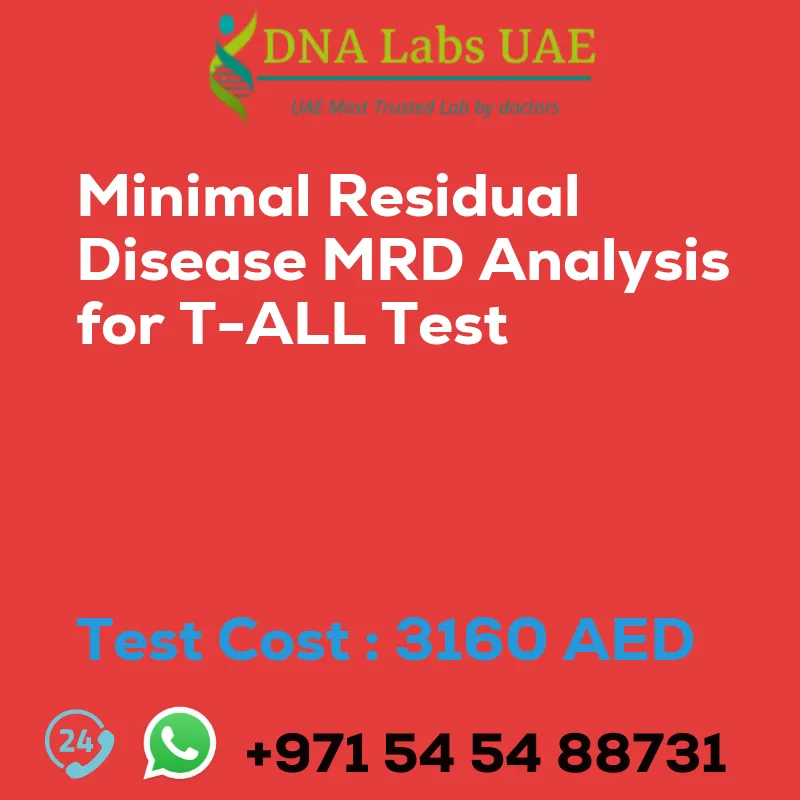MINIMAL RESIDUAL DISEASE MRD ANALYSIS FOR T-ALL
Test Name: MINIMAL RESIDUAL DISEASE MRD ANALYSIS FOR T-ALL
Test Components: Surface and cytoplasmic: *CD3 *CD4 *CD5 *CD7 *CD8 *CD1a *CD16 *CD56 *CD34*TdT *CD99 *CD117 *CD38 *CD10 *CD45 *CD2/CD13/CD15/CD33
Price: 3160.0 AED
Sample Condition: 3 mL (1 mL min.) First pull Bone Marrow aspirate in 1 Green Top (Sodium Heparin) tube AND 4 mL (3 mL min.) whole blood in 1 Green Top (Sodium Heparin) tube. Ship immediately at 18-22°C. DO NOT REFRIGERATE OR FREEZE. It is mandatory to provide Date & Time of sampling, Previous immunophenotype report & Clinical history. All information should be given at the time of registration/before the sample is processed.
Report Delivery: Sample Daily by 9 am; Report 3 Working days
Method: Flow cytometry
Test type: Leukemia
Doctor: Hematologist, Oncologist
Test Department: FLOW CYTOMETRY
Pre Test Information: It is mandatory to provide Date & Time of sampling, Previous immunophenotype report & Clinical history.
Test Details
Minimal residual disease (MRD) analysis for T-cell acute lymphoblastic leukemia (T-ALL) is a diagnostic test used to detect small amounts of cancer cells that may remain in a patient’s body after treatment. T-ALL is a type of blood cancer that affects the lymphocytes, a type of white blood cell. After undergoing treatment, such as chemotherapy, radiation therapy, or stem cell transplant, some cancer cells may still be present in the body at very low levels. These residual cancer cells are called minimal residual disease.
MRD analysis involves the use of sensitive laboratory techniques to detect and quantify these residual cancer cells. The most commonly used method is flow cytometry, which can identify and count specific markers on the surface of cancer cells. Other techniques include polymerase chain reaction (PCR) and next-generation sequencing (NGS), which can detect specific genetic abnormalities associated with T-ALL.
The purpose of MRD analysis is to assess the effectiveness of treatment and to monitor disease progression or relapse. By detecting and quantifying minimal residual disease, doctors can determine if additional treatment is needed or if the disease is in remission. MRD analysis is typically performed at multiple time points during and after treatment, such as after induction therapy, consolidation therapy, and maintenance therapy.
The results are reported as a percentage of cancer cells detected in relation to the total number of cells analyzed. Overall, MRD analysis for T-ALL plays a crucial role in guiding treatment decisions and monitoring the response to therapy. It helps healthcare providers determine the appropriate course of action to achieve the best possible outcomes for patients with T-ALL.
| Test Name | MINIMAL RESIDUAL DISEASE MRD ANALYSIS FOR T-ALL Test |
|---|---|
| Components | Surface and cytoplasmic:*CD3 *CD4 *CD5 *CD7 *CD8 *CD1a *CD16 *CD56 *CD34*TdT *CD99 *CD117 *CD38 *CD10 *CD45 *CD2/CD13/CD15/CD33 |
| Price | 3160.0 AED |
| Sample Condition | 3 mL (1 mL min.) First pull Bone Marrow aspiratein 1 Green Top (Sodium Heparin) tube AND 4 mL (3 mL min.) whole blood in1 Green Top (Sodium Heparin )tube.\nShip immediately at 18-22?\u00f8C. DO NOT REFRIGERATE OR FREEZE. It is mandatory to provide Date & Time of sampling, Previous immunophenotype report & Clinical history. \nAll information should be given at the time of registration\/before the sample is processed. |
| Report Delivery | Sample Daily by 9 am; Report 3 Working days |
| Method | Flow cytometry. |
| Test type | Leukemia |
| Doctor | Hematologist, Oncologist |
| Test Department: | FLOW CYTOMETRY |
| Pre Test Information | It is mandatory to provide Date & Time of sampling, Previous immunophenotype report & Clinical history. |
| Test Details |
Minimal residual disease (MRD) analysis for T-cell acute lymphoblastic leukemia (T-ALL) is a diagnostic test used to detect small amounts of cancer cells that may remain in a patient’s body after treatment. T-ALL is a type of blood cancer that affects the lymphocytes, a type of white blood cell. After undergoing treatment, such as chemotherapy, radiation therapy, or stem cell transplant, some cancer cells may still be present in the body at very low levels. These residual cancer cells are called minimal residual disease. MRD analysis involves the use of sensitive laboratory techniques to detect and quantify these residual cancer cells. The most commonly used method is flow cytometry, which can identify and count specific markers on the surface of cancer cells. Other techniques include polymerase chain reaction (PCR) and next-generation sequencing (NGS), which can detect specific genetic abnormalities associated with T-ALL. The purpose of MRD analysis is to assess the effectiveness of treatment and to monitor disease progression or relapse. By detecting and quantifying minimal residual disease, doctors can determine if additional treatment is needed or if the disease is in remission. MRD analysis is typically performed at multiple time points during and after treatment, such as after induction therapy, consolidation therapy, and maintenance therapy. The results are reported as a percentage of cancer cells detected in relation to the total number of cells analyzed. Overall, MRD analysis for T-ALL plays a crucial role in guiding treatment decisions and monitoring the response to therapy. It helps healthcare providers determine the appropriate course of action to achieve the best possible outcomes for patients with T-ALL. |








